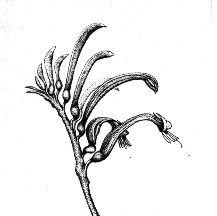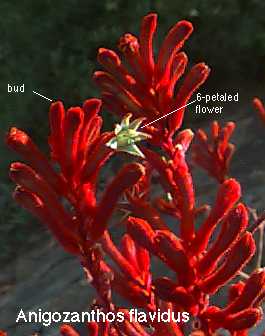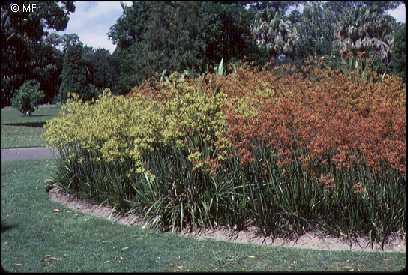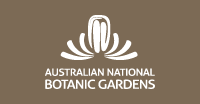 Kangaroo Paws
Kangaroo Paws
The colour and form of kangaroo paws make them one of the most rewarding Australian native plants for the home garden. Kangaroo paws are also very good cut flowers. They are exported to many parts of the globe and are grown commercially in the USA, Israel and Japan.
Kangaroo paws belong to the genus Anigozanthos, which has 11 species. The closely related Black Kangaroo Paw is called Macropidia fulginosa.
Where do they Occur?
Anigozanthos and Macropidia occur naturally only in the southwest of Western Australia. They occur in a variety of habitats and soil types.

Kangaroo Paw Flowers
The size, flower-stalk height and colour of kangaroo paws flowers varies between the species. Many new forms have also arisen as the result of deliberate hybridisation. The overall colour of the flowers is influenced by fine coloured hairs which cover the flowers and, sometimes, part of the stalk. The flowers appear over spring and summer.
The flowers are pollinated by birds. The long flower-stalks usually rise above the undergrowth and 'advertise' the presence of nectar in the flowers. The stalks also provide a perch for visiting birds.
The shape of the flowers and the position of the pollen-bearing anthers is a feature which allows pollen to be deposited on the head of feeding birds. This pollen is transferred from flower to flower as the birds feed. Different species usually deposit pollen on different areas of the birds' head. This means that pollen from one species is unlikely to be deposited in the flowers of another species.
Propagation
Anigozanthos species are commonly propagated from seed. The seed should be sown in a freely draining seed-raising mix during spring and summer. The young plants usually flower after a year. Clumps may also be divided in early summer.
Macropidia fuliginosa is difficult to propagate from seed or by division. Commercially grown plants are usually produced by tissue culture.
Pests and Diseases
A major disease of kangaroo paws is a fungus which causes ink disease, Ink disease appears as large black blotches on the leaves. Plants growing in cool moist climates are more susceptible.
Ink disease is difficult to treat. Vigorously growing plants are more resistant and dividing clumps after several years helps ensure strong growth. In most cases it is better to remove clumps of declining plants and plant new ones. This is especially true of short-lived species. Some disease resistant cultivars are also now available.
To prevent the spread of fungal spores, badly effected leaves should be removed and burnt. In extreme cases, the application of the fungicide, copper oxychloride, may help retard the disease.
Kangaroo paws are also prone to snail and slug attack and special attention should be given to removing them.
Cultivation Requirements
In general kangaroo paws grow best in well-drained soils in a sunny
position. Well-composted organic matter will improve growth.

It is advisable to regard kangaroo paws as short-lived plants. Experience at the Gardens has shown that plant performance declines after 3 to 5 years. Some species, for example, Anigozanthos manglesii, are best considered annuals. Dividing the clumps will help retain vigour. Some organic matter should be added to the soil after division.
Most species are dormant over winter (some die back completely) and it is important not to over-water at this time.
At the Gardens, kangaroo paws are cut back to within about 10 cm of the ground in late winter. In this way diseased and frost damaged leaves are removed, reducing the chance that they will harbour pests and diseases.
Commonly Grown Kangaroo Paws
The following kangaroo paws will grow well in most temperate parts of Australia and most have been successfully cultivated at the Gardens. Many of the most successful cultivars grown at the Gardens are hybrids which have Anigozanthos flavidus as a parent.
Anigozanthos 'Bush Ranger'
A drought tolerant cultivar developed from a hybrid between Anigozanthos flavidus and Anigozanthos humilis. The orange flowers are formed on stalks which grow about 50 cm tall. It can tolerate moderate frosts and has some resistance to ink disease.
Anigozanthos 'Dwarf Delight'
A frost hardy cultivar with flower-stalks which grow to about 80 cm. The flowers appear apricot coloured. The cultivar was developed from a hybrid between Anigozanthos flavidus and Anigozanthos onycis. The cultivar is quite long-lived, some plants have been in cultivation at the Gardens for up to 8 years.
Anigozanthos flavidus
Tall Kangaroo Paw
Illustration
This vigorous species is adaptable to a wide range of soil conditions
and climatic conditions, but can be damaged by heavy frost. The flower-stalk
can grow to 2 m tall. The flowers usually appear yellow-green, but a wide
range of colour forms are available. It is best to buy this species in
flower to determine the flower colour. Plants grow well in full sun or
dappled shade.
Anigozanthos manglesii
Red and Green Kangaroo Paw
Illustration
This short-lived species is often treated as an annual at the Gardens.
The striking red and green flowers are supported on a red stalk which grows
about 1 m. This species is the floral
emblem of Western Australia. The cultivar Anigozanthos 'Bush
Emerald' has similar coloured flowers and is generally easier to grow.
Anigozanthos 'Pink Joey'
This cultivar was probably originally a sport of Anigozanthos flavidus. The flower-spikes grow to about 50 cm.and the flowers are salmon-pink. A hardy plant with similar cultivation requirements to Anigozanthos flavidus.
Macropidia fuliginosa
Black Kangaroo Paw
This species should be cultivated in well-drained soils in a sunny position. Plants are damaged by frost and are difficult to grow in frosty areas. The flowers and stalks are covered by a dense layer of black hairs, through which green can just be seen. Flower-stalks grow to about 1 m.
Further Reading
Australian National Botanic Gardens
Growing Native Plants Number 2, 3rd edition
Australian Government Publishing Service, 1981.
Elliot, W.R. and Jones, D.L.
Encyclopaedia of Australian Plants Suitable for Cultivation, Volumes
1 & 2,
Lothian Publishing (various publication dates).
Society for Growing Australian Plants
Australian Plants, Volume 16 (126), March, 1991.
Wrigley, J. W. and Fagg, M.
Australian Native Plants, 4th edition
Reid, 1996.
![An Australian Government Initiative [logo]](/images/austgovt_brown_90px.gif)







